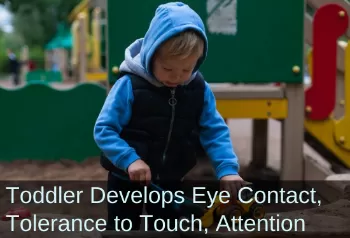Primitive Reflex Integration Case Studies
In Only 6 Weeks, Boy with Constant Movement Becomes Much Calmer and Can Sit to Play with Toys
Rhythmic movements improve attention and participation
This 2.5 year-old boy avoided eye-contact and interacting with others. He moved constantly, was touch-averse, and did not engage in age-appropriate play. His occupational therapist started providing rhythmic movements from the Brain and Sensory Foundations course, and a month and a half he had made substantial gains in all of these areas.
Submitted by Erin Carlson Taylor, MS, OTR/L

| Before | After |
|---|---|
| Constant movement | Much calmer energy |
| Mom had never seen him sit with a puzzle or stacking toy and play with it appropriately | Independently sitting to interact and play with toys for several minutes at a time |
| Avoided the therapist and avoided eye contact | Initiated eye contact with therapist |
| Would not allow the therapist to touch him | Allowed therapist to provide rhythmic rocking in a Lycra swing for several minutes |
| Would not acknowledge when being spoken to nor follow directions | Participated in a put-on-your-socks-and-shoes song in therapist's lap |
| Could not pay attention in speech therapy | Significant improvement in energy and attention in speech therapy |
JC is a 2 ½ year old boy. He was born 9 weeks premature via C-section. He is a quadruplet and weighed 2 pounds, 5 ounces at birth. Mom reports JC was the smallest of his siblings and that she was always worried about him in utero because he remained low in her uterus and she could rarely feel him move. After birth, he was the calmest of the babies and needed little rocking or comforting. Despite the fact that JC received early intervention services in home since birth, he developed a flat head. Mom reports all the babies had some flattening of the head but JC’s was the most pronounced. Mom reports he was the second of his siblings to walk at 13 months and he met all motor developmental milestones on time. At 2, JC started outpatient OT and SLP. At 2 ½ I started seeing him for OT. JC wandered around the therapy room and was in constant movement. He walked primarily on his toes. He did not interact for more than a few seconds with any toys. He avoided the therapist and avoided eye contact. He did not allow the therapist to touch him. He did tolerate mom handling him and gave mom brief eye contact. He did not acknowledge when being spoken to nor follow directions. Mom was taught rhythmic movement #2a [from the Brain and Sensory Foundations course]. She started with about 30 seconds, 5-7x/week at night while he slept. After 1 week there appeared to be some emotional dysregulation and sleep disturbance, but mom wanted to push through. After 2 weeks, JC demonstrated calmer energy and allowed therapist to provide rhythmic rocking in a Lycra swing for several minutes. Mom added rhythmic movements # 3 & 4 at home. After 4 weeks of RMs at home, JC allowed therapist to touch him and provide 30 sec. to 1 min of RM at a time during play even with being sick and missing some appointments. After 6 weeks of consistent rhythmic movements [from the Brain and Sensory Foundations course] at home, JC was demonstrating much calmer energy and was independently sitting to interact and play with toys for several minutes at a time. His mother was thrilled with this behavior as she had never seen him sit with a puzzle or stacking toy and play with it appropriately. He initiated eye contact with therapist 1x during RM in the Lycra swing.
He followed a 1 step direction 2/5X and he participated in a put on your socks and shoes song in therapist's lap and independently stomped foot at the appropriate time 1x. The speech therapist who had been seeing him for the last 6 months also noted a significant change in his energy and attention. JC is the type of child that would be challenging for me to treat without these new tools from the Brain and Sensory Foundations course. Learning his history of little movement in utero and infancy, I knew rhythmic movement would be beneficial, but it was really exciting to see how quickly he was changing and with little actual handling from me. Unfortunately, I was no longer able to see this child due to an abrupt insurance issue and change in clinic.
[Therapist's note regarding toe walking]: When I think back, there probably was improvement compared to that first day I saw him, but it wasn't as significant of a change as some of the other things that were documented.
[Edited for length and clarity, emphasis added]
*Disclaimer: The activities in the Brain and Sensory Foundations curriculum make use of the natural processes of neuroplasticity and development that are innately wired in the design of human beings to promote maturity and function. These activities appear to calm, organize, and mature the neuro-sensory-motor systems just as we see in the healthy development of human infants. Individual results may vary, and we do not claim to offer a diagnosis or cure for any specific condition or disorder. The Brain and Sensory Foundations activities appear to improve overall functioning resulting in measurable improvements for a range of conditions as demonstrated in over 1800 case studies from participants.

